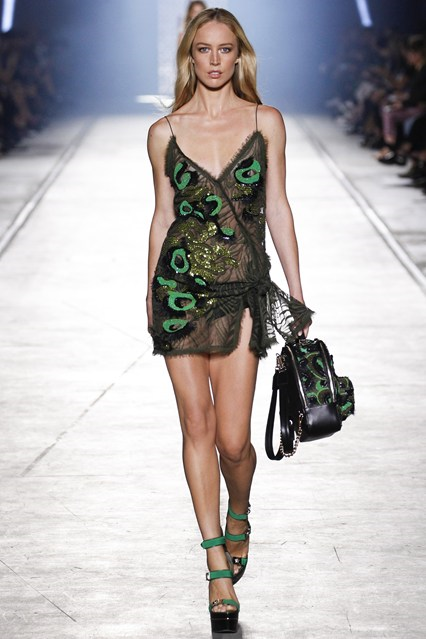Text by Adam Lehrer
It was hard to feel optimistic about Italian fashion after Milan Men’s Fashion Week SS 2017. That’s not to say that there weren’t some great collections, they just happened to come from the reliably interesting brands: Prada, Marni, and Alessandro Michele’s continued Gucci revolution among them. But there was a palatable lack of electricity coming from the Milan menswear shows. Maybe I’m alone in thinking this way, who knows? But Italian opulence just feels increasingly less relevant. I was in Milan last year, and people weren’t dressed up in Versace gold lapels (for some reason I thought some of the men there might be dressed up like The Sopranos’ Furio Giunta). Instead, I found the fashion and art crowds to be dressed similarly to those in New York, London, and Paris: disheveled jeans, cool sneakers, big trench coats or denim jackets. Antonioli, Milan’s arguable coolest high fashion boutique, does far better business with its stock of Vetements, Alyx Studio, Raf Simons, and Rick Owens than it does with local brands like the uninspired Marcelo Burlon or the sharp but off-schedule Milanese brand Julius. As the world grows more globalized, people are becoming at once more homogenized and individualistic in their senses of style. Italian tailoring, as a result, has grown out of favor with fashionistas, artists, and musicians. But these things come in waves of course, and there were just enough interesting shows to argue that “this city will rise again,” to paraphrase Tilda Swinton in Only Lovers Left Alive.
Gucci SS 2017: Weird and Whimsical as a Collection, Desirable and Wearable as Products
Hedi Slimane was successful at Saint Laurent because he was able to create an aesthetic that was easily relatable and undeniably marketable while creating absurdly wearable products within each collection. Rappers, rockers, and actors all bought in and bought in hard, and Saint Laurent Paris was worn on everyone from Kanye and his shredded denim to Marilyn Manson and his leather blazers. Now admittedly, Alessandro Michele is a far more experimental designer than Hedi Slimane has been of late(at least since his days as creative director of Dior Homme). But it’s starting to seem viable that Gucci under Michele could prove to be a financial success on par with Slimane’s Saint Laurent. The fey and whimsical aesthetic might seem jarring to most men, but it reels you in with a barrage of beautiful imagery. Everything from ad campaigns to the Gucci stores have become undeniably vibrant with Michele at the helm. Now that the public interest is at full tilt (Michele and Demna Gvasalia are probably the designers most captivating the industry’s attention at the moment, despite their markedly different aesthetics), he is now introducing key products to his collections that can become mainstays of the Gucci product line.
Michele Gucci SS 2017 menswear show was his last specifically menswear show, as Gucci will be presenting all its menswear and womenswear products via one show in season to come (like every other mega-brand, Gucci too is re-evaluating its business strategy to compensate for the speed of the industry). Its primary theme was travel, which also seemed to be Milan Men’s Fashion Week’s prevailing consistency. But Michele approaches the idea of travel from a different point of view than other designers. He himself has an aversion to physical travel, preferring the travels of the imagination that one experiences while reading a good book or, especially in his case, designing. At the show, he mentioned Marco Polo’s 13th Century travelogue. As a document, the travelogue’s accuracy has been widely disputed. This interested Michele: the travelogue is as much an ode to human imagination as it is to physical movement.
It also makes sense in Gucci’s SS 2017 menswear collection, which (like previous Michele collections) was so rich in ideas that each product could have pages of analysis devoted to it: men wearing womenswear and women wearing menswear, Japanese souvenir jackets decorated by American kitsch, satin suits, ‘70s Kentucky Derby referencing dresses and dresses, leather raincoats, dorky sweater vests, embroiderered tuxedos, and on and on and on.
But to get back to the Slimane comparison, Michele absolutely inundates his shows in product. But like Hedi, Michele is introducing pieces (the souvenir jackets, the loaders, the t-shirts emblazoned with graphic reading “Modern Future”) that could becomes staples of both his collections and fans’ wardrobes. Now that people are buying into his Gucci fantasy, they are going to be looking for pieces that make sense for them. Michele is both ingeniously subversive and inventively business savvy. He is every bit as good as they say he is.
Prada SS 2017: While Most Milanese Designers Looked at Travel, Miuccia Explored Forced Travel
As previously stated, travel was the big theme for Milan Fashion Week SS 2017. Travel is one of the tritest notions in fashion, but like Alessandro Michele at Gucci, Miuccia Prada draped her exploration of travel in conceptual ideas. While Michele’s were poetically personal, Prada’s were conceptually political.
In Prada’s SS 2017 menswear show, the models walked uphill while carrying far too much weight on their shoulders. It immediately brings to mind the forced migrations of Syrians fleeing their ISIL-ravaged country towards safety in Europe. There is of course a ton of baggage that comes with high fashion labels incorporating these sorts of humanitarian political messages in clothing, but that baggage never feels overly apparent within the work of Miuccia Prada. She is, after all, a noted communist. Despite her clothing fetching astronomical sums of money, she seems to hold the belief that quality products limit over-consumption. She has ideas and she cares. There are two Prada costumers. One just loves the idea of Prada as the pinnacle of all things “chic” and modern, and one really understands the messages set forth by Ms. Prada.
The nylon backpack seemed to be the centerpiece of this collection; blown out to gargantuan proportions, it seemed to emphasize the collection’s exaggerated sense of utilitarianism. While the garments looked rooted in active wear, they were also capital “F” fashion. There were plays on silhouettes and a wide range of color and graphic arrangement. There was something here for every type of discerning Prada buyer.
Damir Doma SS 2017: A Diversified Color Palette Lightens the Usual Shapes
Damir Doma is a lot more influential in that “ninja goth” thing that went on a few years ago than he ever gets credit for. His garments, usually all in black and draped baggy over bodies, are less conceptual than those of, say, Rick Owens, but also in some ways more commercial. But Doma has remained committed to his aesthetic even as that trend has died down, and maybe that’s why he’s still here when so many of those designers died fast and hard (anyone remember En Noir?). Those baggy and frayed clothes came in a diversified palette for SS 2017: black, white, hunter green, mustard yellow, and navy. There wasn’t much anything going overly conceptual here, but jut about any of the pieces would ne nice to wear. I’m as sick of writing about MA-1 jackets as the next person, but Doma’s were quite nice: baggy sleeves, loose hem, and kimono flaps that could be attached in lieu of using the zippers. I also love the t-shirts that came with an extra piece of fabric tye-dyed to look like red flames. The womenswear pieces were nice but all looked a bit too ‘90s Yohji to really make an impact. When Doma was still in Paris, he was massively overshadowed by the glut of revolutionary designers living in the city. Italy was a good choice for him; his slightly oft-kilter clothes allow him to provide welcome respite from the glut of corporate luxury houses.
Marni SS 2017: Consuelo Identifies the Male Counterpart to Her Waify Nerd Intellectual Lady
Consuelo Castiglioni has defined a whole genre of women with the Marni label. You know the type of woman that I’m talking about here: she works in a gallery or perhaps runs an antique design bookshop, she has big classes, a waif-y build, an a charmingly odd personality. Muses include Margot Tenenbaum, Patti Mayonaise, and the flashback younger version of Orange is the New Black’s most endearing paranoid schizophrenic, Lolly Whitehill. The label’s menswear offering have always felt less essential. Most likely this is due to the assumption that any guy who looks stylishly normcore doesn’t have much interest in fashion. The problem is that isn’t really true, and Castiglioni has finally defined the man who buys Marni with SS 2017.
Adorned in an inexplicable amount of Velcro, Marni SS 2017 was fashionably dorky, proving that a confident can be as magnetic as a confident whatever else. The first look was a doozy: a light blue leather trench coat over a sloppily cut suit and a checked shirt. Followed by an even stranger ensemble: leather shorts (!) checked crewneck, and flip-flops. Nothing quites makes sense with Marni, but when put together it looks quite well-defined.
Fendi SS 2017: Working Man’s Fabrics, Rich Man’s Garments
Silvia Fendi used the terry cloth favored by Pablo Picasso as the jumping off point for the Fendi SS 2017 menswear collection. Though not used in every look, the fabric was used in most and influenced the overall direction of the collection. That direction was laid back and luxurious. But that’s kind of what Fendi always is. So this was a pretty good Fendi menswear collection.
ANNND that’s really about it. It felt like Gucci was about to lead a revolution in Milan, but it seems more accurate that Michele simply had a revolution at Gucci. Most of the other good collections (Calvin Klein, No. 21, MP) didn’t use a runway show, opting to show off their garments to buyers. Milan Men’s Fashion Week was extremely lackluster.











